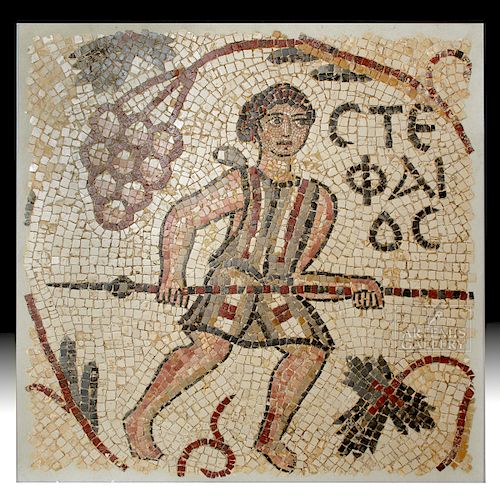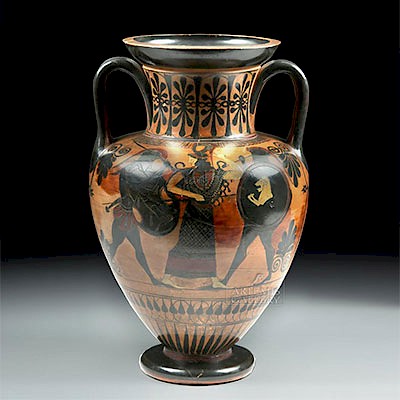Roman Stone Mosaic Spear Thrower & Grapevine
Lot 34a
About Seller
Artemis Fine Arts
686 S Taylor Ave, Ste 106
Louisville, CO 80027
United States
Selling antiquities, ancient and ethnographic art online since 1993, Artemis Gallery specializes in Classical Antiquities (Egyptian, Greek, Roman, Near Eastern), Asian, Pre-Columbian, African / Tribal / Oceanographic art. Our extensive inventory includes pottery, stone, metal, wood, glass and textil...Read more
Estimate:
$28,000 - $32,000
Absentee vs Live bid
Two ways to bid:
- Leave a max absentee bid and the platform will bid on your behalf up to your maximum bid during the live auction.
- Bid live during the auction and your bids will be submitted real-time to the auctioneer.
Bid Increments
| Price | Bid Increment |
|---|---|
| $0 | $25 |
| $300 | $50 |
| $1,000 | $100 |
| $2,000 | $250 |
| $5,000 | $500 |
| $10,000 | $1,000 |
| $20,000 | $2,500 |
| $50,000 | $5,000 |
| $100,000 | $10,000 |
| $200,000 | $20,000 |
About Auction
By Artemis Fine Arts
Oct 11, 2018
Set Reminder
2018-10-11 10:00:00
2018-10-11 10:00:00
America/New_York
Bidsquare
Bidsquare : Exceptional Antiquities | Ethnographic Art
https://www.bidsquare.com/auctions/artemis-gallery/exceptional-antiquities-ethnographic-art-3500
An important one-day auction featuring museum-worthy examples of classical antiquities, ancient and ethnographic art from cultures encompassing the globe. Artemis Fine Arts info@artemisfinearts.com
An important one-day auction featuring museum-worthy examples of classical antiquities, ancient and ethnographic art from cultures encompassing the globe. Artemis Fine Arts info@artemisfinearts.com
- Lot Description
Roman, the Levant, late Imperial Period, ca. 3rd to 5th century CE. A fascinating stone mosaic depicting a full-length youth gripping a spear with both hands and motioning toward his left with bent legs and his shoulders leaning in as his large eyes peer in that same direction - suggesting that the target of his gaze is also the target of his spear. Above is an oversized grapevine and a Greek inscription with leafy tendrils in the field. The inscription translates, "Stephaios" referring to his name - a variation of Stephanos meaning "wreath" or "crown" - the type awarded after an athletic victory and commonly used as a name. In this context, it may mean that this fellow is "worthy of a crown." Size: mosaic measures ~ 29" W x 29" H (73.7 cm x 73.7 cm); 30.25" W x 30.25" H (76.8 cm x 76.8 cm) including plaster matrix and metal frame
The athletic young man wears a colorful tunic of grey, red, black, and white stone tesserae. His body is nicely modeled in peach, red, white, taupe, and yellow tesserae, with a sharp black outline. The artist went to great lengths to depict the volumes of the figure's flesh and even details like his Adam's apple, his curly auburn coiffure, dewy skin, and the light in his eyes.
Mosaics (opus tesellatum) are some of our most enduring images from the Roman world, exciting not only for their aesthetic beauty, but also because they reveal what Romans chose to depict and see every day decorating their private and public spaces. In the Roman province of Syria, which encompassed most of the ancient Near East/Levant, mosaics developed as a popular art form relatively late, with most finds coming from the 3rd century CE or later. Syria was one of Rome's wealthiest provinces, but it was also far removed from Rome itself and Roman culture was overlaid on enduring cultural traditions from Hellenistic Greece and the great civilizations that came before it. Antioch-on-the-Orontes (modern day Antakya, Turkey), was the capital of northern Roman Syria, and its excavations in the 1930s revealed more than three hundred mosaic pavements - of which many embellished public baths. Popular mosaic themes from this region were often mythological or religious scenes, depicting gods and goddesses. This example, featuring a large grapevine, was probably set in a room with a bacchanalian theme referencing Bacchus, god of the fruit of the vine, winemaking, theatre, and revery.
Provenance: private East Coast, USA collection
All items legal to buy/sell under U.S. Statute covering cultural patrimony Code 2600, CHAPTER 14, and are guaranteed to be as described or your money back.
A Certificate of Authenticity will accompany all winning bids.
We ship worldwide and handle all shipping in-house for your convenience.
#139195Expected losses to edges and some areas of the composition, with some nicks, abrasions, and fissures to tesserae commensurate with age. Set in a modern plaster matrix with a metal frame.Condition
- Shipping Info
-
All shipping is handled in-house for your convenience. Your invoice from Artemis Gallery will include shipping calculation instructions. If in doubt, please inquire BEFORE bidding for estimated shipping costs for individual items.
-
- Buyer's Premium



 EUR
EUR CAD
CAD AUD
AUD GBP
GBP MXN
MXN HKD
HKD CNY
CNY MYR
MYR SEK
SEK SGD
SGD CHF
CHF THB
THB















